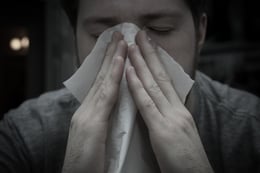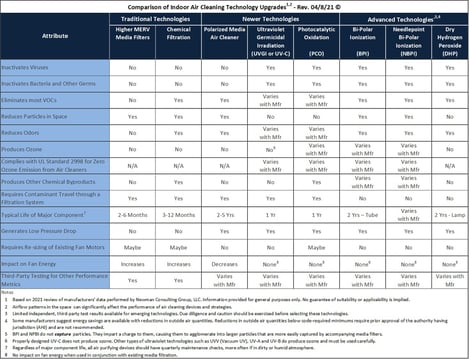Some estimates place the cost of poor indoor air quality (IAQ) to the United States' economy at $200 Billion in today’s dollars. In the age of COVID-19, good IAQ as we have known it is no longer enough. (Updated chart, 2/25/21)
Let’s break it down:
- The Coronavirus, the virus that causes the disease COVID-19 is a pathogen.
- A pathogen is a bacterium, virus, or other microbe that can cause disease.
- We often think of them collectively as “germs.”
- We are surrounded by pathogens (bacterial, fungal or viral) inside our bodies, on our bodies, inside our buildings and on the surfaces around us - every second of every day.
- For every human cell in your body there are 10 bacterial cells on you and in you.
 Our bodies and our environment will never be free of bacteria and microbes, nor should they be. The idea is both insane and impossible. A normal human immune response easily handles the vast majority of this continual contact.
Our bodies and our environment will never be free of bacteria and microbes, nor should they be. The idea is both insane and impossible. A normal human immune response easily handles the vast majority of this continual contact.
IAQ in the COVID Era
Then there’s COVID-19, the disease (COronaVIrus Disease, 2019) caused by the Coronavirus, also known as Severe Acute Respiratory Syndrome COronaVirus 2 (SARS-CoV-2). Yes, it’s related to the SARS virus that affected China in 2003, and the MERS (Middle East Respiratory Syndrome) that spread in 2012 and 2015.
What makes this virus so difficult to manage?
- Spreads through tiny aerosols (not just coughing and sneezing, but breathing, speaking and singing as well).
- Spreads through indirect contact (lives longer on surfaces like doorknobs, railings, etc.).
- Transfers from infected people with no symptoms.
While we don’t yet know how to stop it, like with a vaccine, we do know how to significantly decrease our risk. In addition to wearing masks, frequent hand washing and staying a minimum of six feet apart, building owners can better manage building operation and maintenance to improve air quality in a way that will further minimize risk.
Nothing about owning or managing a building will be normal – perhaps for quite a while. In addition to CDC, OSHA and WHO guidelines, industry experts at ASHRAE, BOMA and others have released their own statements and guides. See newmanconsultinggroup.us/web-sites for a list of Covid-19-related resources, including this recent, detailed presentation on best practice protocols going forward. Respected organizations, such as facility management firms JLL, CBRE and many others have issued their own guides for preparing your building before returning to “business as usual.”
Respected organizations, such as facility management firms JLL, CBRE and many others have issued their own guides for preparing your building before returning to “business as usual.”
It is in every building owner’s and manager’s best interests to become familiar with all these materials. Your tenants and employees may already be using these guides, and if they are not, you can help make them aware. What we know today is less than what we will know tomorrow, so keep checking for new information.
Modern Technology to Clean and Disinfect
Because the virus is transmitted through droplets in the air, ensuring better IAQ to help prevent the spread of COVID-19 is critical. For this we look to various systems that our clients can use throughout their HVAC systems.
Air handling units (AHUs) are the nexus of power, performance and bio-load in our buildings today. When we properly disinfect, remove and control the growth and spread of biofilms we can greatly reduce the microbial load.
To keep AHUs and the buildings they service clean we look to the various air filtration and cleaning and disinfecting systems. The most common ones include HEPA (High Efficiency Particulate Air) Media Filtration, UV (Ultra-Violet Light) Purification and Bi-Polar Ionization. Each has pros and cons.
Balancing Air Flow, Humidity and Occupant Comfort
Many organizations, including ASHRAE, recommend using 100% outside air (OA) to flush buildings (minimum of 4 hours daily). Its effectiveness depends on OA temperature and humidity at the time of flushing. Heating and cooling systems in most buildings are sized for a small percentage of OA, typically 10-20%. Raising that to 100% puts significant additional strain on the system.
For example: If 100% OA at 90F and 70% relative humidity (RH) – typical for summer - is brought into a commercial building during normal working hours, the cooling system may be able to reduce that temperature to only approximately 70F with an actual increase in RH. On average, systems introduce air at about 55F into working spaces. At 70F with high humidity, people will be uncomfortable and may not be willing to work. Some may even feel ill.
To make this feasible, 100% OA should be used only when the temperature is 50-60F with low humidity (typically overnight in northern climates). If temperatures are above 60F and humidity is higher, using less OA over a longer time may prove more effective. When the temperature exceeds 65F it’s helpful to pre-cool the space overnight to reduce the temperature and humidity. Then return to normal OA (10-20%) during the day.
Flushing in this manner is one of many tools and will most certainly be more effective when used with one of the other disinfecting strategies mentioned earlier, such as BPI or UV-C and better filtration. These strategies must be employed to make the HVAC system more functional, not only to remove viruses, but also to keep the utility costs, and wear and tear on all components of the system, more reasonable.
Moving Forward Together
Stay current with what is available. Do your research, or hire a knowledgeable, experienced consultant. Combine various methodologies to make the total system more effective (see chart above).
Remember that “Perception Is Reality.” When someone has a concern, a bit of compassion and prompt attention to the issue go a long way toward showing that you care. Educate your teams and tenants on the new safety procedures and expectations. Swift, proper implementation of effective strategies will help people feel safer and more secure as we venture into the new, or “now” normal.
For expert advice on choosing the right system for your building, call Jim at Newman Consulting Group.





